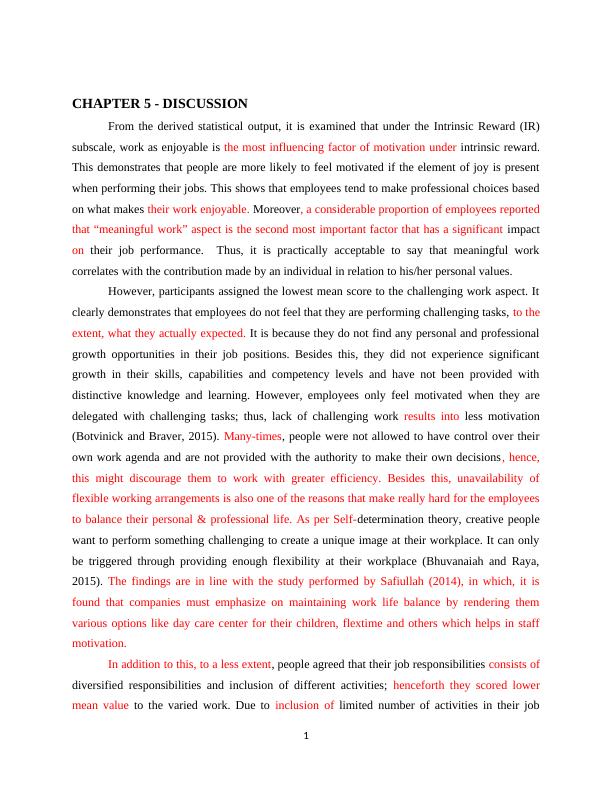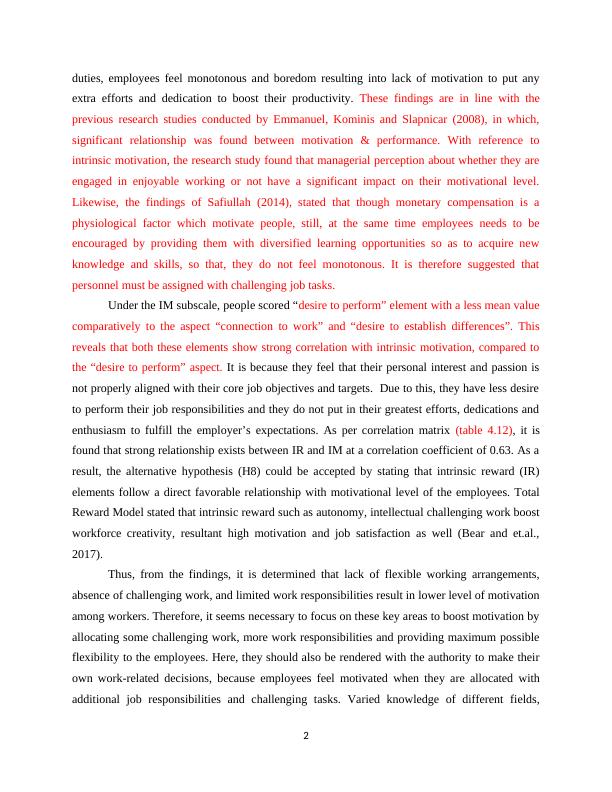Ask a question from expert
Influencing Factor of Motivation Doc
11 Pages3344 Words52 Views
Added on 2020-07-22
Influencing Factor of Motivation Doc
Added on 2020-07-22
BookmarkShareRelated Documents
RESEARCH PROJECT (CHAPTER: DISCUSSION)

TABLE OF CONTENTSCHAPTER 5 - DISCUSSION.........................................................................................................1RECOMMENDATIONS.................................................................................................................4LIMITATIONS................................................................................................................................5SUGGESTIONS FOR THE FUTURE RESEARCH......................................................................5CONCLUSION................................................................................................................................6

CHAPTER 5 - DISCUSSIONFrom the derived statistical output, it is examined that under the Intrinsic Reward (IR)subscale, work as enjoyable is the most influencing factor of motivation under intrinsic reward.This demonstrates that people are more likely to feel motivated if the element of joy is presentwhen performing their jobs. This shows that employees tend to make professional choices basedon what makes their work enjoyable. Moreover, a considerable proportion of employees reportedthat “meaningful work” aspect is the second most important factor that has a significant impacton their job performance. Thus, it is practically acceptable to say that meaningful workcorrelates with the contribution made by an individual in relation to his/her personal values.However, participants assigned the lowest mean score to the challenging work aspect. Itclearly demonstrates that employees do not feel that they are performing challenging tasks, to theextent, what they actually expected. It is because they do not find any personal and professionalgrowth opportunities in their job positions. Besides this, they did not experience significantgrowth in their skills, capabilities and competency levels and have not been provided withdistinctive knowledge and learning. However, employees only feel motivated when they aredelegated with challenging tasks; thus, lack of challenging work results into less motivation(Botvinick and Braver, 2015). Many-times, people were not allowed to have control over theirown work agenda and are not provided with the authority to make their own decisions, hence,this might discourage them to work with greater efficiency. Besides this, unavailability offlexible working arrangements is also one of the reasons that make really hard for the employeesto balance their personal & professional life. As per Self-determination theory, creative peoplewant to perform something challenging to create a unique image at their workplace. It can onlybe triggered through providing enough flexibility at their workplace (Bhuvanaiah and Raya,2015). The findings are in line with the study performed by Safiullah (2014), in which, it isfound that companies must emphasize on maintaining work life balance by rendering themvarious options like day care center for their children, flextime and others which helps in staffmotivation. In addition to this, to a less extent, people agreed that their job responsibilities consists ofdiversified responsibilities and inclusion of different activities; henceforth they scored lowermean value to the varied work. Due to inclusion of limited number of activities in their job1

duties, employees feel monotonous and boredom resulting into lack of motivation to put anyextra efforts and dedication to boost their productivity. These findings are in line with theprevious research studies conducted by Emmanuel, Kominis and Slapnicar (2008), in which,significant relationship was found between motivation & performance. With reference tointrinsic motivation, the research study found that managerial perception about whether they areengaged in enjoyable working or not have a significant impact on their motivational level.Likewise, the findings of Safiullah (2014), stated that though monetary compensation is aphysiological factor which motivate people, still, at the same time employees needs to beencouraged by providing them with diversified learning opportunities so as to acquire newknowledge and skills, so that, they do not feel monotonous. It is therefore suggested thatpersonnel must be assigned with challenging job tasks. Under the IM subscale, people scored “desire to perform” element with a less mean valuecomparatively to the aspect “connection to work” and “desire to establish differences”. Thisreveals that both these elements show strong correlation with intrinsic motivation, compared tothe “desire to perform” aspect. It is because they feel that their personal interest and passion isnot properly aligned with their core job objectives and targets. Due to this, they have less desireto perform their job responsibilities and they do not put in their greatest efforts, dedications andenthusiasm to fulfill the employer’s expectations. As per correlation matrix (table 4.12), it isfound that strong relationship exists between IR and IM at a correlation coefficient of 0.63. As aresult, the alternative hypothesis (H8) could be accepted by stating that intrinsic reward (IR)elements follow a direct favorable relationship with motivational level of the employees. TotalReward Model stated that intrinsic reward such as autonomy, intellectual challenging work boostworkforce creativity, resultant high motivation and job satisfaction as well (Bear and et.al.,2017). Thus, from the findings, it is determined that lack of flexible working arrangements,absence of challenging work, and limited work responsibilities result in lower level of motivationamong workers. Therefore, it seems necessary to focus on these key areas to boost motivation byallocating some challenging work, more work responsibilities and providing maximum possibleflexibility to the employees. Here, they should also be rendered with the authority to make theirown work-related decisions, because employees feel motivated when they are allocated withadditional job responsibilities and challenging tasks. Varied knowledge of different fields,2

End of preview
Want to access all the pages? Upload your documents or become a member.
Related Documents
Impact of Rewards System on Employee Performance in Delivery Industrylg...
|27
|9476
|279
Motivation and Job Design: Key Concepts in Organizational Behaviorlg...
|9
|2819
|441
The Effectiveness of Rewards System on Employee Motivationlg...
|16
|5267
|205
Factors Influencing Employee Motivationlg...
|8
|2680
|71
Case Study on Next Plc- Motivational Theorieslg...
|17
|5202
|371
Impact of Employee Motivation on Organizational Performance: A Case Study of Woolworths, Australialg...
|11
|2431
|188